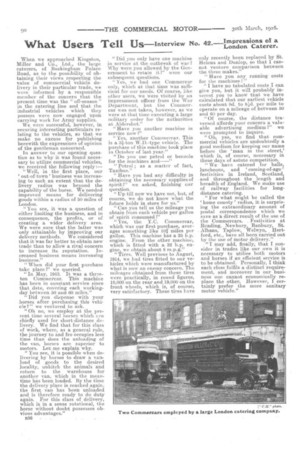What Users Tell Us—Interview No. 42 . _Impressions of a
Page 8

If you've noticed an error in this article please click here to report it so we can fix it.
London Caterer.
When we approached Kingston, Miller and Co., Ltd., the large caterers, of Buckingham Palace Road, as to the possibility of obtaining their views respecting the value of commercial vehicle de livery in their particular trade, we were informed by a responsible member of the concern that the present time was the " off-season" in the catering line and that the industrial vehicles which they possess were now engaged upon carrying work for Army supplies.
We were successful, however, in securing interesting particulars relating to the vehicles, so that we make no excuse for publishing herewith the expressions of opinion of the gentleman concerned.
In answer to our opening question as to why it was found necessary to utilize commercial vehicles, we received the following reply:— " Well, in the first place, our ' out-of-town ' business was increasing to such an extent that the delivery radius was beyond the capability of the horse. We needed improved means for delivering goods within a radius of 50 Miles of London.
"You see, it was a question of either limiting the business, and in consequence, the profits, or of creating a wider delivery area. We were sure that the latter was only attainable by improving our delivery methods. We considered that it was far better to obtain new trade than to allow a rival concern to increase its reputation. Increased business means increasing lausineKt."
"When did your first purchase take place ?" we queried. "In May, 1913. It was a threeton Commercar. This machine has been iu constant service since that date, covering each workingday between 50 and 60 miles.'
Did you dispense with your horses after purchasing this vehicle ? " we ventured to ask.
"Oh no, we employ at the present time several horses which are chiefly used for short-distance delivery. We find that for this class of work, where, as a general rule, the journey to and fro occupies less time than does the unloading of the van, horses are superior to motors. Let me explain why. "You see, it is possible when delivering by horses to draw a van.load of goods to the desired locality, unhitch the animals and return to the warehouse for another van, which in the meantime has been loaded. By the time the delivery place is reached again, the first van has been unloaded and is therefore ready to do duty again. For this class of delivery, which is in a sense rotational, the horse without doubt possesses obvious advantages."
B36 "Did you only have one machine in service at the outbreak of war ? Why were you allowed by the Government to retain it?" were our subsequent questions.
"Yes, we had one Commercar only, which at that time was sufficient for our needs. Of course' like other users, we were visited by an impressment officer from the War Department, but the Commercar was not taken, however, as we were at that time executing a large military order for the authorities at Aldershot."
"Have you another machine in service now ?"
"Yes, another Commercar. This is a *ton W.D.-type vehicle. The purchase of this machine took place in October of last year."
"Do you use petrol or benzole for the machines and—" " Petrol ; as a matter of fact, Taxibus."
"Have you had any difficulty in obtaining the necessary supplies of spirit?" we asked, finishing our question.
"Up till now we have not, but, of course, we do not know what the future holds in store for us." "Can you tell us the mileage you obtain from each vehicle per gallon of spirit consumed ?" "Yes, the Y.C. Commercar, which was our first purchase, averages something like 10i miles per gallon. This machine has a 25 ltp. engine. From the other machine, which is fitted with a 32 h.p. engine, we obtain about 8 m.p.g." "Tires. Well previous to August, 1914, we had tires fitted to our vehicles which were manufactured by what is now an enemy concern. The mileages obtained from these tires were practically, in round figures, 18,000 on the rear and 19,000 on the front wheels, which is, of course, very satisfactory. These tires have only recently been replaced by St. Helens and Dunlop, so that I cannot venture comparison between the three makes."
"Have you any running costs for the machines 1" "I have no tabulated costs I can give you, but it will probably interest you to know that we have calculated that our earliest vehicle costs about 84. to 81.d. per mile to operate on a mileage of between 50 and 60 per day.
"Of course, the distance traversed affords your concern a valuable advertising medium 7" we were prompted to inquire_
"Oh, yes, we find that comtheroial vehicles are undoubtedly a good medium for keeping our name before the 'man in the street,' which is, of course, necessary in these days of astute competition. " We have catered for balls, luncheons, and ' coming-of-age ' festivities in. Ireland, Scotland, and throughout the length and breadth of England. We make use of railway facilities for longdistance cateri% . "For what might be called the 'home county' radius, it is surprising the extraordinary amount of postal correspondence which we save as at direct result of the use of the Commercars. . Festivities at Reading, Newbury, Banbury, St. Albans, Taplow, Welwyn, Hertford, etc., have all been carried out by the use of motor delivery."
"I may add, finally, that I consider in trades like our own it is necessary to utilize both motors and horses if an efficient service is to be obtained. Personally, I think each class fulfils a distinct requirement, and moreover in our business one cannot economically replace the other. However, I certainly prefer the more sanitary motor vehicle."






















